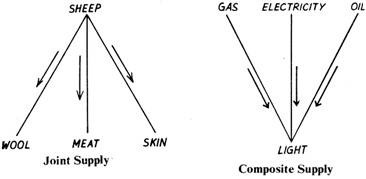As there are cases of inter-related demand, e.g., joint demand and composite demand, similarly there are cases of inter-related supply, viz., joint supply and composite supply.
Joint Supply:
Joint supply refers to goods supplied or produced jointly. Some commodities have a common origin and are produced in the same process.
Examples are wheat and straw, cotton and cotton seed, wool, and mutton, etc. When any one of them is produced, the other is produced automatically. For instance, when we produce wheat, the straw comes out itself. One is called the main product, e.g., wheat, and the other is called the by-product, e.g., straw.
In some cases, the joint products are produced in nearly fixed proportions, e.g., cotton and cotton seed. Their proportions cannot be varied. In other eases, the proportion can be varied. For example, it has been found that is possible through cross-breeding to breed sheep either for wool or for meat. The quantity of one can be increased at the expense of the other.
Composite Supply:
ADVERTISEMENTS:
When there are different sources of supply of a commodity-or service, we say that its supply is composed of all these sources. You can get light from electricity, gas, kerosene oil, candles, etc. All these sources go to make up the supply of light.
It is a case of composite supply. Whenever there are substitutes or rival sources of supply, the supply is composite. There is competition among them and the most economical source of supply is tapped first. But they also combine and co-operate to satisfy the same need.
